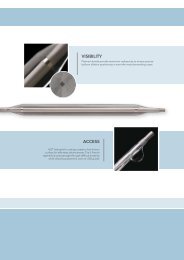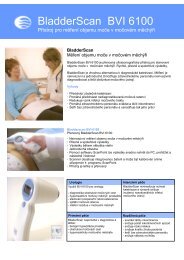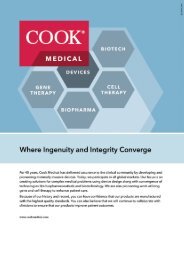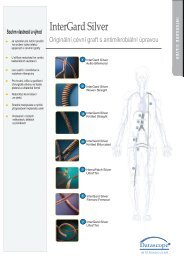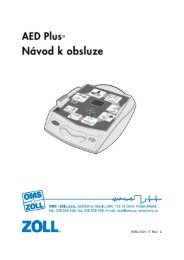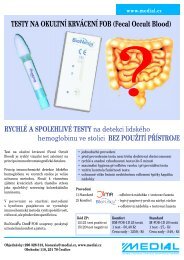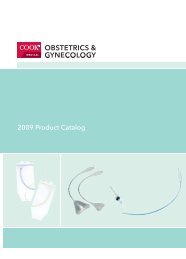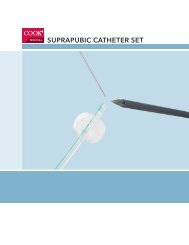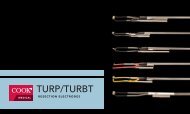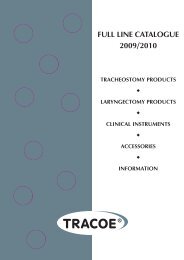The BAP test and the global assessment of oxidative stress ... - Medial
The BAP test and the global assessment of oxidative stress ... - Medial
The BAP test and the global assessment of oxidative stress ... - Medial
Create successful ePaper yourself
Turn your PDF publications into a flip-book with our unique Google optimized e-Paper software.
In particular, 140 Labrador Retriever dogs,75 females <strong>and</strong> 55 males, between 1 <strong>and</strong> 5years old, fed with <strong>the</strong> same super-premiumdry food <strong>and</strong> with <strong>the</strong> same lifestyle, wereincluded in a study (25). All <strong>the</strong> subjects werein good health conditions at <strong>the</strong> physical <strong>and</strong>laboratory examination (haemogram,biochemical pr<strong>of</strong>ile, urine analysis <strong>and</strong> serumprotein electrophoresis) (25).<strong>The</strong> <strong>BAP</strong> <strong>test</strong> showed linear in <strong>the</strong> <strong>test</strong>edinterval (Figure 9), with a 0,95 “r” coefficient.µEq/L2500.002000.001500.001000.00500.00R 2 =0.950.000 20 40 60 80 100 120%Figure 9. Linearity <strong>of</strong> <strong>BAP</strong> <strong>test</strong> (data from canineplasma) (modified by Pasquini et al, 2008) (25).<strong>The</strong> recovery values <strong>of</strong> accuracy turned out106,41%. <strong>The</strong> within-run CV WAS 6,4 %, while<strong>the</strong> between-run CV was 8,1% (25). <strong>The</strong>sedifferences, compared to <strong>the</strong> lower data shownin Humans, can be at least partially ascribableto pre-analytical errors. In fact, preliminaryreports on rats indicate that <strong>the</strong> intake <strong>of</strong> food<strong>and</strong>/or antioxidants significantly increases <strong>the</strong>basal value <strong>of</strong> <strong>the</strong> <strong>BAP</strong> <strong>test</strong>. <strong>The</strong>refore, it ism<strong>and</strong>atory to perform <strong>the</strong> <strong>BAP</strong> <strong>test</strong> in <strong>the</strong> samepre-analytical conditions <strong>of</strong> o<strong>the</strong>r biochemical<strong>test</strong>s, like blood glucose (<strong>the</strong> morning, at rest).This should significantly decrease anyvariability <strong>of</strong> <strong>the</strong> <strong>BAP</strong> <strong>test</strong> even in <strong>the</strong> sameindividual.Taken toge<strong>the</strong>r, <strong>the</strong>se findings indicate that<strong>the</strong> <strong>BAP</strong> <strong>test</strong> shows good to excellent analyticalperformances as a reliable tool to assessantioxidant status in blood samples ei<strong>the</strong>r fromHumans or Animals.<strong>The</strong>se performances were shown improvedrecently by automating <strong>the</strong> <strong>test</strong> on a multipleanalyzer (OLYMPUS 450) (data submitted forpublication).Interestingly, <strong>BAP</strong> <strong>test</strong> showed excellentrepeatability on o<strong>the</strong>r biological matrices, likewater-soluble antioxidant formulas, with anintra-assay coefficient <strong>of</strong> variation 1.9% (seebelow, Studies in Vitro).At <strong>the</strong> moment, <strong>the</strong> only describedinterfering factor as well as for all photometricassays is a very high blood level <strong>of</strong> lipids (seebelow).6. Interpretation <strong>of</strong> resultsAccording to <strong>the</strong> data <strong>of</strong> <strong>the</strong> Producer(Diacron International, Grosseto, Italy), <strong>the</strong>“optimal value” <strong>of</strong> <strong>BAP</strong> <strong>test</strong> in healthy peoplesshould be at least 2.200 µEq/L.Benedetti et al. confirmed this finding, byshowing values 2169 ± 105 µEq/L on plasmablood samples (n=12) from apparently healthypeoples, selected among a more largepopulation <strong>of</strong> healthy blood donors(unpublished data).Noticeably <strong>the</strong>se values are very similar to<strong>the</strong>se very recently reported by Nagata et al. in50 healthy volunteers (2137 ± 228 µEq/L)(26).<strong>The</strong>refore, <strong>the</strong> normal range proposed by<strong>the</strong> producer is substantially confirmed by<strong>the</strong>se preliminary data (see also below, ClinicalStudies on Humans).In o<strong>the</strong>r words, values lower than 2.200µEq/L indicate a reduced “biological potential”<strong>and</strong> hence a decreased effectiveness <strong>of</strong> <strong>the</strong>antioxidant plasma barrier, according to anarbitrary scale <strong>of</strong> severity (Table 5).Table 5. <strong>BAP</strong> <strong>test</strong> results <strong>and</strong> antioxidant barrierimpairment.<strong>BAP</strong> <strong>test</strong> results Impairment degree <strong>of</strong>(µEq/L) plasma antioxidant barrier2.200 – 2.000 Border line condition2.000 – 1.800 Slight reduction1.800 – 1.600 Moderate reduction1.600 – 1.400 Strong reduction< 1.400 Very strong reductionOptimal value > 2.200 µEq/L12www.fras4evolvo.it



